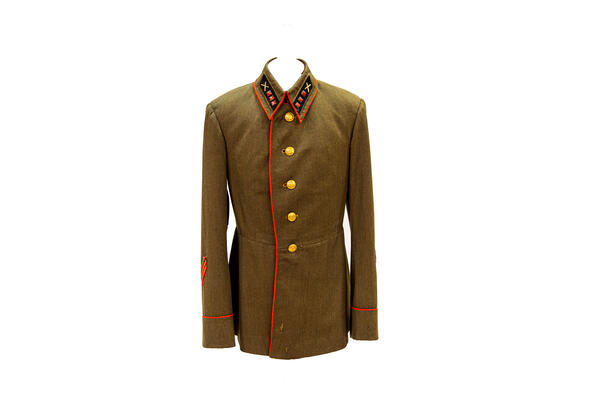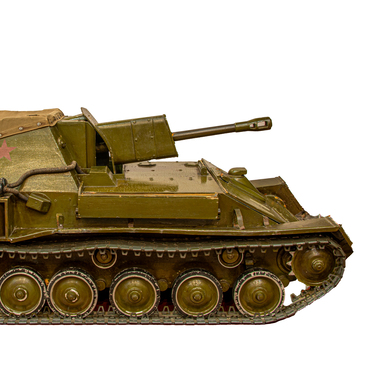By the mid-1930s changes were made to the uniforms of the Workers 'and Peasants' Red Army: it was necessary to introduce special parade or go-ashore clothes that would differ from every-day, working or guard uniforms. On September 22, 1935, the Central Executive Committee and the Council of People’s Commissars of the USSR established personal military ranks for all military personnel. In December of the same year, by order of the People’s Commissariat of Defense, new insignia (on gorget patches and sleeves of uniforms, jackets and overcoats) and new uniforms appeared. The 1935-1940 artillery uniform is on display at the Museum.
At the end of 1936 the new rules divided the uniform into casual, marching and guard uniforms. As a rule, the marching one differed from the everyday one only by the presence of a steel helmet and route order. On the contrary, some items were missing from the guard uniform: a flask, a kettle, binoculars, and others.
However, there were also more significant differences. For example, the uniforms of the command staff differed from those of junior commanders and Red Army soldiers in quality and cut.
In addition, clothing and uniforms were strictly divided by color: each type and branch of the army was assigned its color. This scheme was so successful that no attempt was made to change it until the mid-1960s, and some of its elements are still in place today.
The artillery also had its colors. The artilleryman Anton Trichleb’s uniform, displayed in the museum, has red edgings on the detachable collar, sleeve cuffs and gorget patches. The gorget patches and the headband are black.
Anton Trikhleb was born in 1915 in Voroshilovgrad Region and graduated from the Odessa Artillery School before the war. Lieutenant Trikhleb was assigned to the 108th Artillery Regiment in Kolomna. Moreover, in 1939 he was appointed commander of the ninth battery in the newly formed 403rd howitzer artillery regiment.
On the first day of World War II, Trikhleb was drafted to the front. He participated in the battles near the city of Orsha in the Smolensk region, and after being wounded, he fought in a partisan detachment. In August 1942, Anton Trikhleb was captured, and ended up in Auschwitz. After his release, he returned to Kolomna.
At the end of 1936 the new rules divided the uniform into casual, marching and guard uniforms. As a rule, the marching one differed from the everyday one only by the presence of a steel helmet and route order. On the contrary, some items were missing from the guard uniform: a flask, a kettle, binoculars, and others.
However, there were also more significant differences. For example, the uniforms of the command staff differed from those of junior commanders and Red Army soldiers in quality and cut.
In addition, clothing and uniforms were strictly divided by color: each type and branch of the army was assigned its color. This scheme was so successful that no attempt was made to change it until the mid-1960s, and some of its elements are still in place today.
The artillery also had its colors. The artilleryman Anton Trichleb’s uniform, displayed in the museum, has red edgings on the detachable collar, sleeve cuffs and gorget patches. The gorget patches and the headband are black.
Anton Trikhleb was born in 1915 in Voroshilovgrad Region and graduated from the Odessa Artillery School before the war. Lieutenant Trikhleb was assigned to the 108th Artillery Regiment in Kolomna. Moreover, in 1939 he was appointed commander of the ninth battery in the newly formed 403rd howitzer artillery regiment.
On the first day of World War II, Trikhleb was drafted to the front. He participated in the battles near the city of Orsha in the Smolensk region, and after being wounded, he fought in a partisan detachment. In August 1942, Anton Trikhleb was captured, and ended up in Auschwitz. After his release, he returned to Kolomna.



